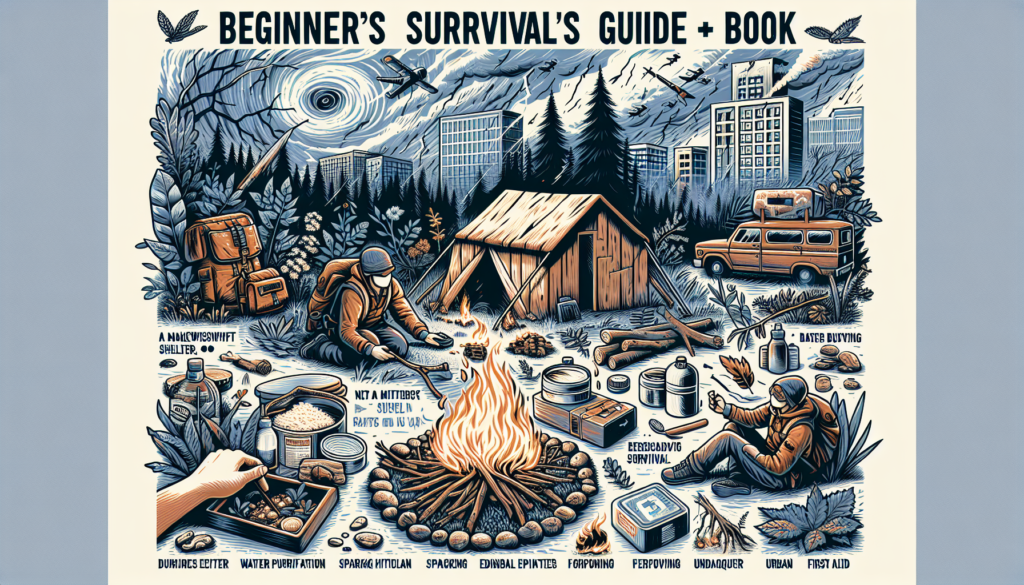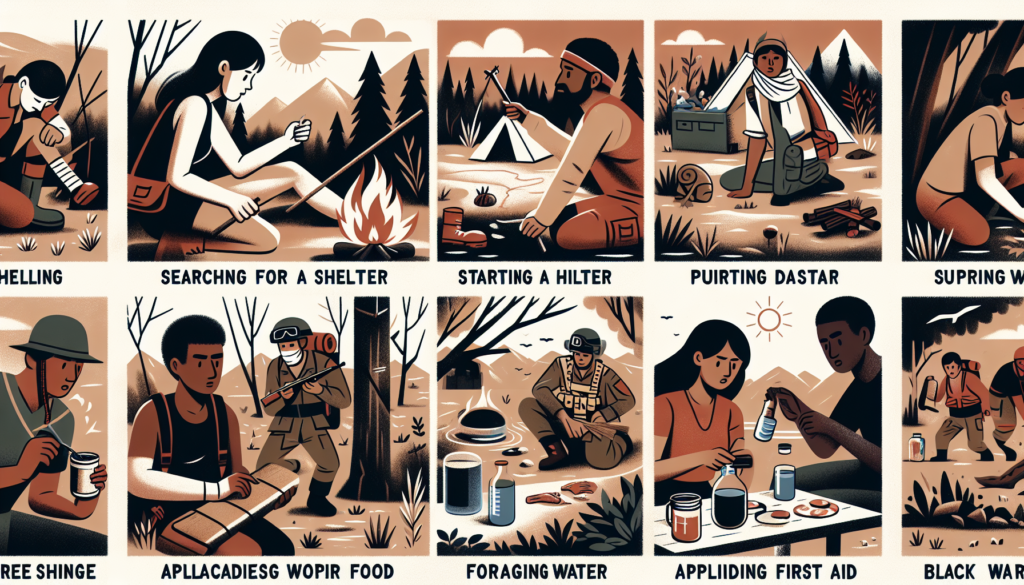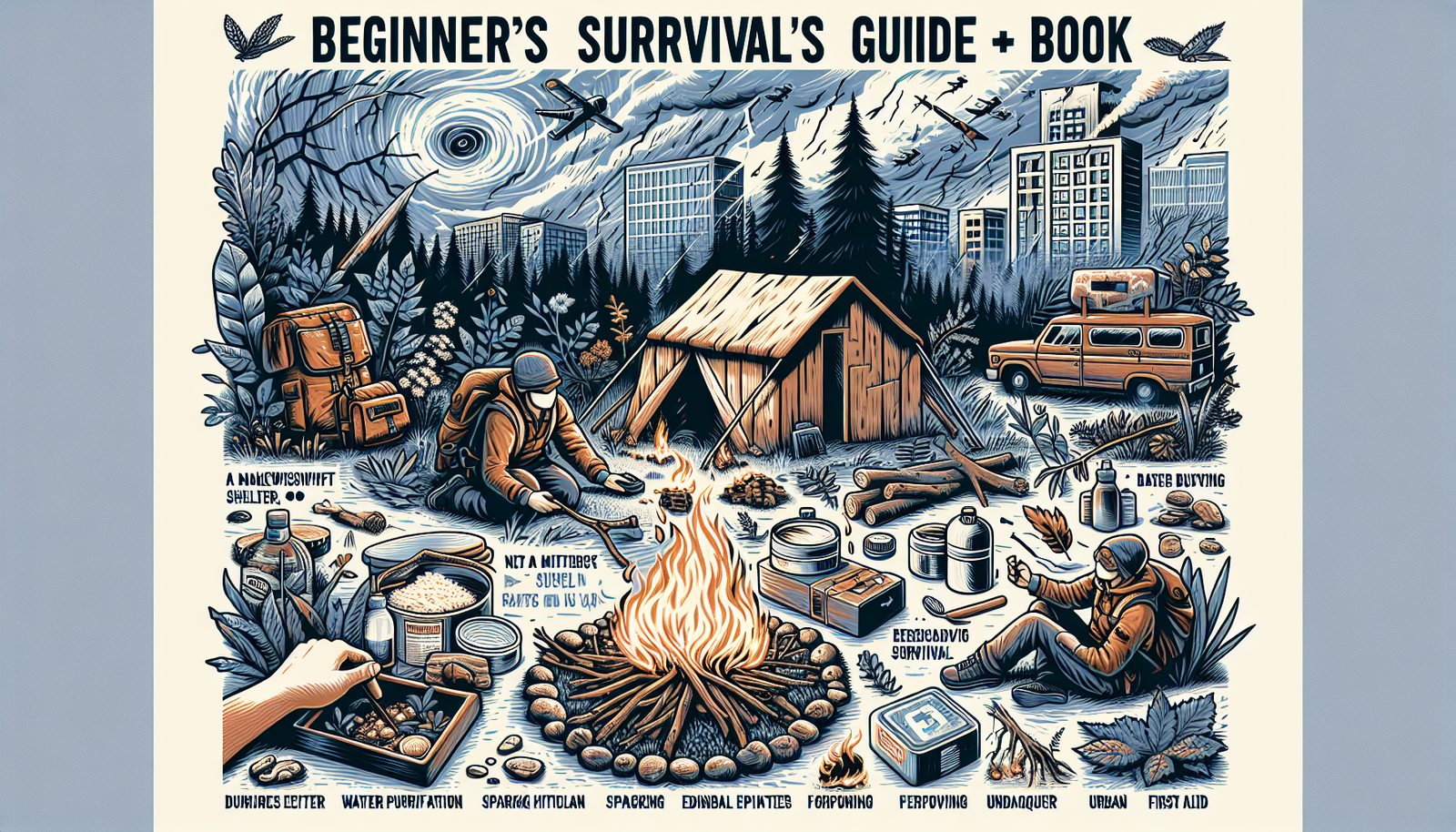In this comprehensive guide, “Survival Tips For Beginners”, you will find a wealth of information to help you navigate the world of basic survival skills. Whether you’re new to outdoor adventures or a seasoned explorer, this resource will provide you with essential techniques and tips to ensure your safety and preparedness. From learning the fundamentals of outdoor survival to mastering Wilderness Survival Skills, we’ve got you covered. Our goal is to equip you with the knowledge and resources needed to confidently handle any situation that may arise. So, let’s delve into this exciting journey of discovery together and empower you with the skills you need to thrive in the great outdoors.

Outdoor Survival Basics
Welcome to our ‘Basic Survival Skills’ section, where beginners and seasoned adventurers alike can discover essential survival techniques and tips. Our comprehensive guide covers a wide range of topics, from ‘Outdoor Survival Basics’ to ‘Wilderness Survival Skills’, ensuring you’re prepared for any situation. Whether you’re looking to learn primitive survival skills or seeking an extensive ‘Survival Skills Checklist’, our resources are designed to equip you with the necessary knowledge.
Identifying and Assessing Risks
When it comes to outdoor survival, being able to identify and assess risks is crucial. Before venturing into the wilderness, take the time to research and understand the potential dangers you may encounter, such as dangerous wildlife, extreme weather conditions, or rugged terrains. By being aware of these risks, you can better prepare yourself and minimize potential dangers.
Building a Shelter
Building a shelter is an essential skill that can protect you from the elements and provide a sense of security in the wilderness. Look for natural materials such as branches, leaves, and rocks to construct a shelter that suits your needs. Consider factors like insulation, protection from wind and rain, and finding a safe location away from potential hazards.
Finding and Purifying Water
Water is fundamental for survival, and knowing how to find and purify it is crucial. Look for natural water sources such as streams or rivers, but be cautious of waterborne diseases and potential contaminants. To purify water, you can boil it, use water purification tablets, or invest in a portable water filter.
Starting a Fire
Fire not only provides warmth but also serves as a signaling tool and a means to cook food. Learning how to start a fire using various techniques, such as friction-based methods or using fire starters, is an essential skill. Practice fire safety and ensure you have access to a reliable fire extinguishing method.
Navigating without a Compass
While having a compass is ideal, learning to navigate without one is a valuable skill, especially in situations where you may not have one available. Familiarize yourself with natural landmarks, such as mountains or rivers, and study the night sky to navigate using celestial bodies like the North Star. Additionally, learning basic map reading skills can greatly assist in orienting yourself.
Food and Nutrition
Foraging for Edible Plants
Knowing how to identify edible plants in the wilderness can be a lifesaver. Thoroughly research the native plants in the area you plan to explore and learn to identify and differentiate them from poisonous plants. Be cautious and gather only what you are confident is safe to consume.
Basic Hunting and Trapping
In a survival situation, knowing how to hunt and trap animals can provide you with a valuable food source. Learn about local wildlife and study their behaviors and habitats. Practice setting traps and understand the ethical considerations involved in hunting for survival.
Preparing and Cooking Food
Properly preparing and cooking food ensures it is safe to consume and maximizes nutrition. Learn how to clean and cook wild game, as well as prepare edible plants for consumption. Carry essential cooking tools and practice efficient cooking techniques to conserve resources.
Avoiding Poisonous Plants
Just as it is important to know which plants are edible, it is equally vital to recognize and avoid poisonous plants. Educate yourself on toxic plants common to the area you will be in, and be cautious when foraging or gathering plants for consumption. If in doubt, err on the side of caution and avoid consuming unknown plants.
Essential Tools and Equipment
Choosing a Survival Knife
A survival knife is a versatile tool that can assist in various survival tasks, from building shelters to preparing food. When choosing a survival knife, consider factors such as blade material, handle grip, and overall durability. Test different knives and ensure they are well-maintained and kept sharp.
Building a Basic Survival Kit
A well-prepared survival kit is essential for any outdoor adventure. Include items such as a first aid kit, fire starters, water purification methods, navigation tools, a flashlight, and emergency shelter materials. Tailor your kit to the specific environment and activities you will be engaging in.
Using a Multi-tool
A multi-tool is a compact and versatile tool that combines several functions in one. It can include features such as a knife, pliers, screwdrivers, and bottle openers. Familiarize yourself with using a multi-tool and explore its various functions to determine its usefulness in different survival situations.
Understanding Cordage
Cordage, or rope, is an essential item in survival situations. Learn how to tie various knots and understand the different types of cordage available. Practice using cordage for tasks such as building shelters, securing food, and creating improvised tools or traps.
Selecting Proper Clothing
Choosing the right clothing is crucial for outdoor survival. Dress in layers to accommodate changing weather conditions and ensure you have clothing that provides insulation and protection from rain, wind, and cold. Invest in quality outdoor clothing and footwear that is durable and comfortable for extended periods in the wilderness.
Emergency Signaling and Communication
Using a Whistle
A whistle is a simple yet effective tool for attracting attention in emergency situations. Carry a whistle and learn specific whistle codes or signals that can communicate distress or other messages. Three short blasts, for example, can indicate a call for help.
Building Signal Fires
Signal fires can be seen from afar and can attract attention in emergency situations. Learn how to build an effective signal fire, using readily available materials such as dry leaves, branches, or brightly colored fabrics. Ensure you have a means to safely extinguish the fire when no longer needed.
Creating Improvised Signals
In situations where you may not have access to traditional signaling devices, learning how to create improvised signals is crucial. Use mirrors, reflective surfaces, or even rocks and sticks to create symbols or patterns that can indicate distress or communicate messages.
Utilizing a Mirror for Signaling
A small mirror or other reflective surface is a handy tool for signaling over long distances. Learn how to use the reflection of the sun to create flashes of light that can attract attention. Practice aiming the reflection towards potential rescuers or passing aircraft.
Basic Radio Communication
Having knowledge of basic radio communication can be invaluable in emergency situations. Learn how to operate a basic two-way radio and familiarize yourself with common emergency frequencies. Practice efficient communication techniques and understand the limitations of radio communication in different environments.

First Aid and Medical Care
Creating a Basic First Aid Kit
A well-stocked first aid kit is essential for addressing minor injuries and medical emergencies in the wilderness. Include items such as bandages, antiseptic wipes, pain relievers, and any specific medication you may require. Research and attend first aid courses to learn proper techniques for various injuries.
Treating Wounds and Injuries
Knowing how to treat wounds and injuries is crucial in a survival situation. Learn techniques such as cleaning and dressing wounds, splinting fractures, and managing bleeding. Additionally, understand the signs and symptoms of common wilderness injuries and how to respond appropriately.
Performing CPR and Rescue Breathing
Cardiopulmonary Resuscitation (CPR) and rescue breathing can save a life in emergency situations. Take a certified first aid course to learn these lifesaving techniques and practice regularly to maintain proficiency. Be prepared to provide emergency medical care while awaiting rescue.
Recognizing and Treating Hypothermia
Hypothermia is a potentially life-threatening condition that can occur in cold weather or wet environments. Learn to recognize the signs and symptoms of hypothermia, such as shivering, confusion, and loss of coordination. Learn how to effectively treat hypothermia, including rewarming techniques and preventing further heat loss.
Dealing with Insect Bites and Stings
Insect bites and stings can be uncomfortable and potentially dangerous. Learn how to identify common insects and understand the associated risks. Carry proper insect repellent and know how to administer first aid for insect bites or stings, such as using antihistamine creams or applying cold compresses.
Survival Psychology
Maintaining a Positive Mental Attitude
Your mental attitude plays a significant role in survival situations. Stay positive and maintain a resilient mindset to overcome challenges. Focus on your strengths and past successes and practice gratitude for the resources and skills you possess.
Developing Resilience
Resilience is the ability to adapt and bounce back from difficult situations. Build resilience by exposing yourself to challenging environments and gradually expanding your comfort zone. Learn from setbacks and view them as opportunities for growth.
Managing Stress and Panic
Stress and panic can impair decision-making and hinder survival efforts. Practice stress management techniques such as deep breathing, meditation, and visualization. Establish a calm and rational approach to problem-solving to mitigate stress and panic.
Coping with Isolation
In survival situations, isolation can be mentally challenging. Find ways to occupy your time and maintain a sense of purpose. Engage in activities such as journaling, exploring your surroundings, or practicing survival skills to stay mentally stimulated.
Building and Maintaining Confidence
Confidence in your abilities is essential for survival. Build confidence by continuously improving your skills and knowledge through practice and learning. Celebrate small victories and acknowledge your progress along the way.
Wilderness Navigation
Reading a Topographic Map
Topographic maps provide detailed information about the terrain and can be invaluable for navigation. Learn how to read contour lines, interpret symbols, and understand the scale and legends of topographic maps. This knowledge will assist you in finding your way through unfamiliar landscapes.
Using a Compass
A compass is a reliable tool for accurate navigation. Familiarize yourself with the basic components of a compass and how to use it to determine direction. Practice orienteering exercises to hone your compass skills and increase your confidence in navigating using this tool.
Navigating by the Stars
In situations where you may not have access to a compass, the stars can serve as your navigational guide. Learn to identify key constellations and understand how they move across the night sky throughout the seasons. Use them to determine cardinal directions and navigate accordingly.
Following Landmarks
Landmarks can be a valuable tool for navigation, especially in areas with distinctive features. Learn to identify and remember prominent landmarks such as mountains, rivers, or unique rock formations. Use these landmarks as reference points to guide you on your journey.
Using GPS and Technology
While traditional navigation methods are essential, technology such as GPS devices or smartphone apps can be valuable additions to your navigation toolkit. Familiarize yourself with using GPS devices and understand their limitations, such as battery life and satellite connectivity. Always have alternative navigation methods in case of technological failure.
Firearms and Self-defense
Understanding Gun Safety
If you choose to carry a firearm for self-defense or hunting purposes, it is crucial to prioritize safety. Understand the basic principles of gun safety, such as always treating a gun as if it is loaded, keeping your finger off the trigger until ready to shoot, and being aware of your target and what is beyond it. Seek proper training and regularly practice safe gun handling techniques.
Choosing the Right Firearm
Selecting the right firearm for self-defense or survival requires careful consideration of factors such as intended use, size, weight, and personal preference. Research different types of firearms and seek advice from experienced professionals before making a decision. Remember that proper training and familiarity with the chosen firearm are essential.
Shooting Techniques
If carrying a firearm, it is crucial to develop proper shooting techniques to ensure accuracy and effectiveness. Seek professional training in firearms handling and practice regularly at a safe and designated shooting range. Master proper shooting stances, grip techniques, and target acquisition to increase your proficiency.
Self-defense Strategies
Self-defense techniques can provide critical protection in dangerous situations. Enroll in self-defense classes to learn practical techniques such as strikes, blocks, and effective defensive postures. Additionally, practice situational awareness and avoid potentially dangerous situations whenever possible.
Legal Considerations
Understand the laws and regulations regarding firearms and self-defense in your jurisdiction. Familiarize yourself with the specific regulations regarding carrying firearms in the wilderness or in areas where you may encounter wildlife. Be responsible and adhere to all legal requirements to avoid legal complications.
Surviving Extreme Environments
Cold Weather Survival
Surviving in cold weather requires preparation and knowledge. Learn about hypothermia prevention, proper layering of clothing, and building shelters that can retain heat. Carry essential cold-weather gear, such as insulated clothing, hand warmers, and emergency blankets.
Hot Weather Survival
In hot weather, staying hydrated and protected from the sun’s rays is crucial. Learn how to prevent heat-related illnesses by drinking plenty of water, seeking shade, and wearing lightweight, breathable clothing. Familiarize yourself with desert survival techniques, such as conserving water and recognizing signs of dehydration.
Mountain and Alpine Survival
Surviving in mountainous or alpine environments presents unique challenges. Understand the risks associated with high altitudes, such as altitude sickness and hypoxia. Learn mountaineering techniques, including route planning, understanding avalanche risks, and proper equipment usage.
Surviving at Sea
Surviving at sea requires specific knowledge and skills. Familiarize yourself with maritime survival techniques, such as using flotation devices, signaling for help, and practicing sea navigation. Learn how to secure potable water and find or improvise shelter while adrift or stranded at sea.
Surviving in the Desert
The desert can be an unforgiving environment, and surviving in it requires specialized knowledge. Learn how to conserve water, identify edible desert plants, and protect yourself from extreme temperatures. Carry essential desert survival gear, such as sun protection, navigation tools, and emergency signaling devices.
Building and Maintaining a Survival Mindset
Setting Realistic Goals
When faced with a survival situation, it is crucial to set realistic goals that align with your available resources and capabilities. Assess your situation and formulate achievable objectives, such as finding shelter, gathering food, or signaling for help.
Adapting to Changing Situations
Survival situations can be unpredictable, and being able to adapt to changing circumstances is vital. Remain flexible and open-minded, and be willing to modify your plans as necessary. Assess new information and adjust your strategies accordingly to increase your chances of survival.
Learning from Mistakes
Mistakes are inevitable, but they offer valuable learning opportunities. Take the time to assess and analyze any mistakes made during your survival experience. Recognize areas for improvement and actively seek ways to refine your skills and decision-making processes.
Practicing Perseverance
Perseverance is vital in survival situations, as it can be mentally and physically exhausting. Push yourself to keep going, even when faced with adversity. Remember your goals and maintain a positive attitude to overcome challenges and stay motivated.
Continuously Improving Skills
Survival skills require practice and refinement. Continuously seek to improve your skills and knowledge through practice, training, and exposure to new environments. Regularly assess your strengths and weaknesses, and actively work toward becoming a more proficient survivor.
In conclusion, acquiring basic survival skills is essential for anyone embarking on outdoor adventures. From identifying and assessing risks to mastering survival techniques in extreme environments, these skills can make the difference between life and death. Remember to always prioritize safety, learn from experienced professionals, and continually practice and refine your skills. With the right mindset, knowledge, and tools, you can confidently face any survival situation that comes your way. Stay prepared and stay safe!

